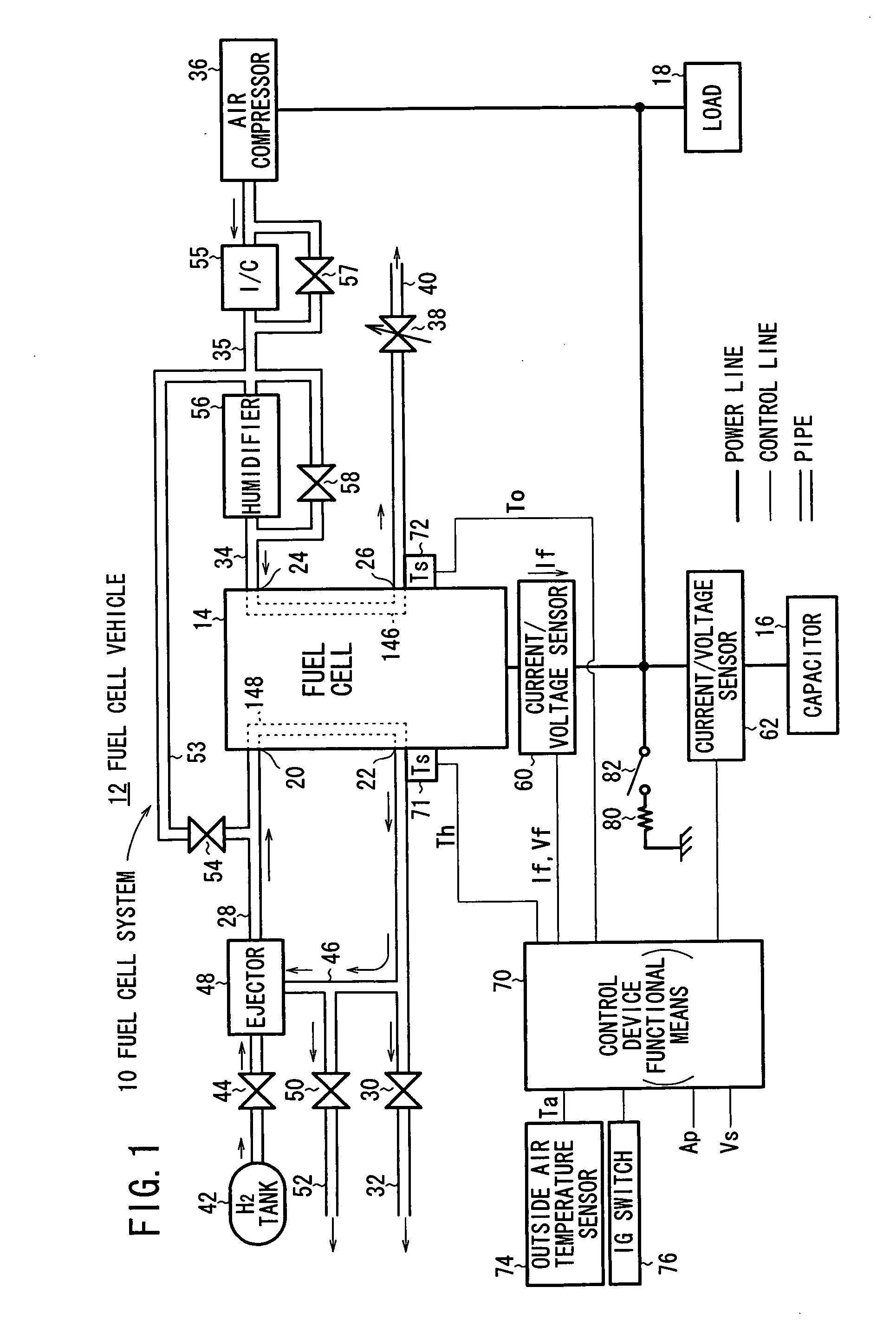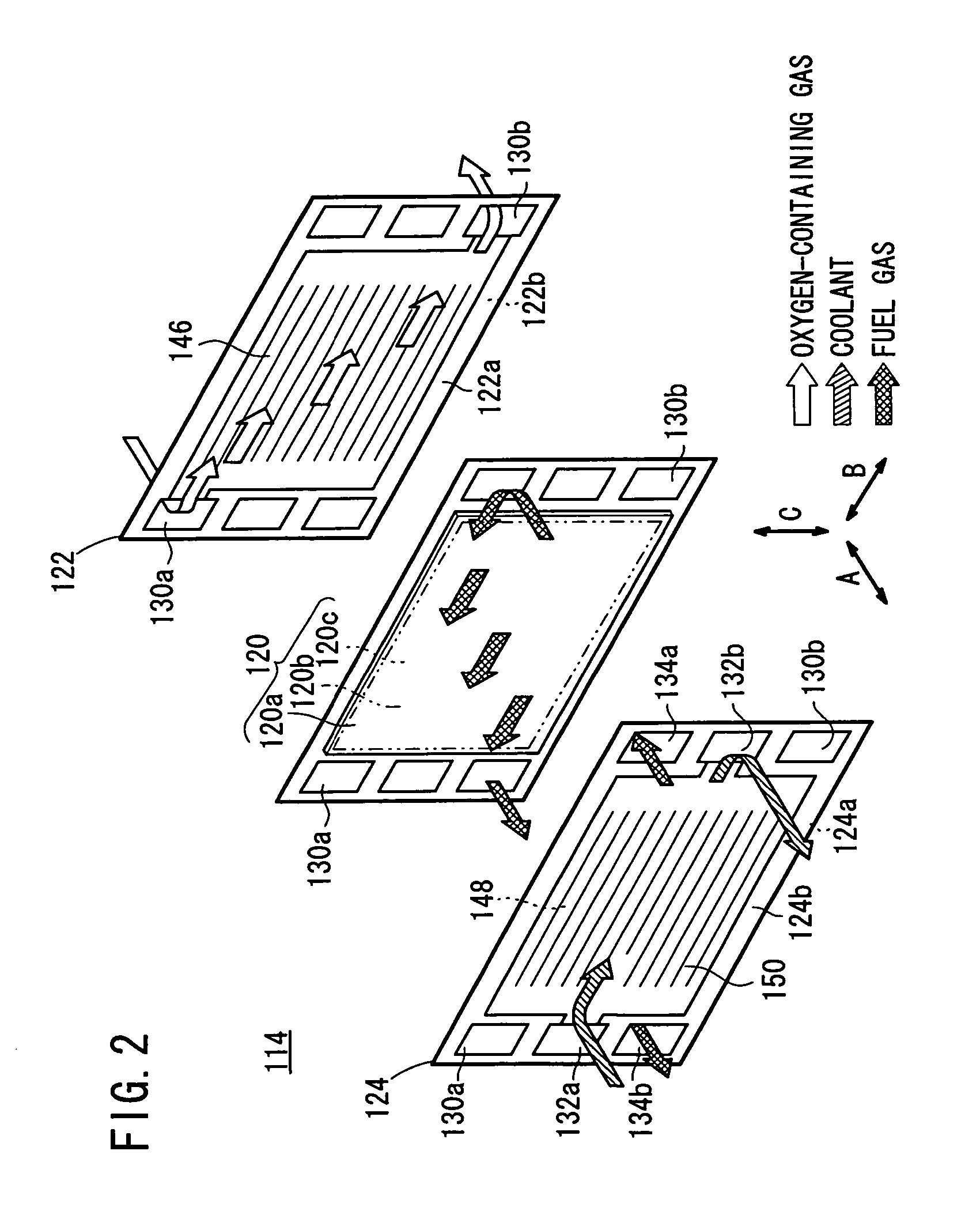Fuel cell system and scavenging method for use in a fuel cell system
a fuel cell and scavenging technology, which is applied in the direction of battery/fuel cell control arrangement, electrochemical generators, transportation and packaging, etc., can solve the disadvantage of loud noise, large amount of water produced by power generation, and small amount of water produced at the anode, so as to reduce noise, reduce energy consumption, and reduce energy consumption
- Summary
- Abstract
- Description
- Claims
- Application Information
AI Technical Summary
Benefits of technology
Problems solved by technology
Method used
Image
Examples
first embodiment
[0086]FIG. 1 is a diagram schematically showing the structure of a fuel cell vehicle 12 equipped with a fuel cell system 10 according to the present invention.
[0087] Basically, the fuel cell vehicle 12 includes a fuel cell 14, a capacitor 16, a load 18 including a motor that is driven to propel the fuel cell vehicle 12, and an auxiliary device such as an air compressor 36. The capacitor 16 serves as an energy storage means, in which a power generation current If of the fuel cell 14 is stored, and which assists the output of the fuel cell 14. For example, an electric double layer capacitor may be used as the capacitor 16. A battery may be used as an energy storage means instead of the capacitor 16, or both a battery and a capacitor 16 may be used.
[0088] The fuel cell 14 has a stacked structure, which is formed by stacking a plurality of cells each including an anode, a cathode, and a solid polymer electrolyte membrane interposed between the anode and the cathode.
[0089] Specifically...
second embodiment
[0168]FIG. 12 is a diagram schematically showing the structure of a fuel cell vehicle 12A equipped with a fuel cell system 10A according to the present invention.
[0169] The fuel cell system 10A differs from the fuel cell system 10 shown in FIG. 1, in that the fuel cell system 10A further includes a flow rate sensor (flow rate detection means) 89 disposed in the hydrogen supply channel 28, for measuring a volume flow rate in order to determine the hydrogen consumption amount. Further, a flow rate sensor or a flow rate meter (flow rate detection means) 91 also is disposed in the air discharge channel 40, for measuring a volume flow rate in order to determine an accumulated air flow amount. In addition, a humidification sensor (humidification detection means) 92 for measuring a relative humidity RH in the air discharge channel 40, and a wind speed sensor (wind speed detection means) 93 for measuring wind speed, are provided. The flow rate sensors 89, 91, and the humidification sensor 9...
third embodiment
[0191]FIG. 15 is a diagram schematically showing the structure of a fuel cell vehicle 12B equipped with a fuel cell system 10B, according to the present invention.
[0192] The fuel cell system 10B differs from the fuel cell system 10 shown in the example of FIG. 1, in that the fuel cell system 10B additionally includes a flow rate sensor (flow rate detection means) 91 provided in the air discharge channel 40, for measuring a volume flow rate and to determine an accumulated air flow rate, and a humidification sensor (humidification detection means) 92, for measuring a relative humidity RH in the air discharge channel 40. Further, in FIG. 15, a dilution box 90, which is connected to the hydrogen purge channel 32 and the discharge channel 52, a further discharge channel 94 having one end connected to the discharge port of the dilution box 90 and the other end connected to the outside, and a timer 73 provided in the control device 70, also are shown. As described above, the dilution box 9...
PUM
 Login to View More
Login to View More Abstract
Description
Claims
Application Information
 Login to View More
Login to View More - R&D
- Intellectual Property
- Life Sciences
- Materials
- Tech Scout
- Unparalleled Data Quality
- Higher Quality Content
- 60% Fewer Hallucinations
Browse by: Latest US Patents, China's latest patents, Technical Efficacy Thesaurus, Application Domain, Technology Topic, Popular Technical Reports.
© 2025 PatSnap. All rights reserved.Legal|Privacy policy|Modern Slavery Act Transparency Statement|Sitemap|About US| Contact US: help@patsnap.com



